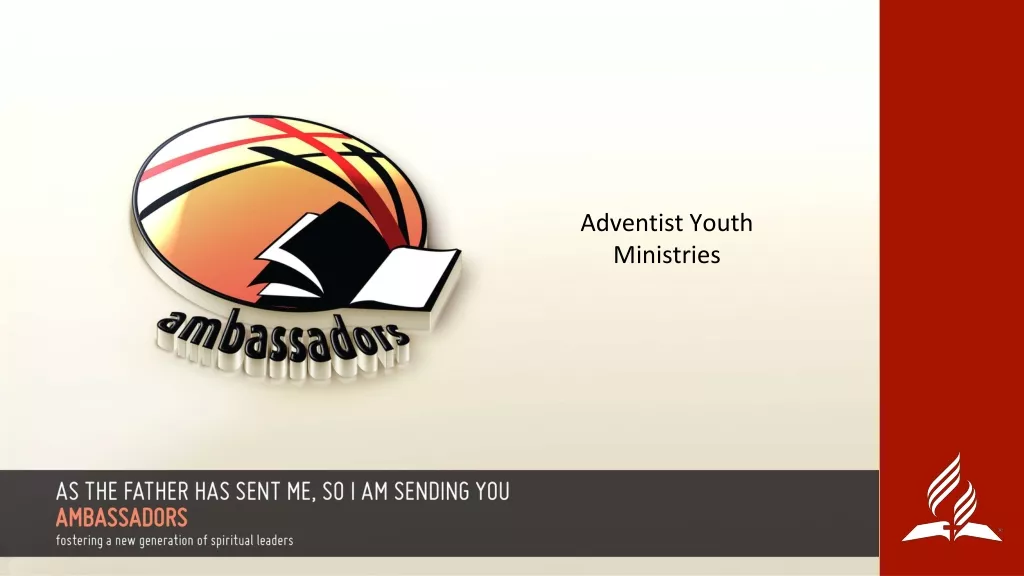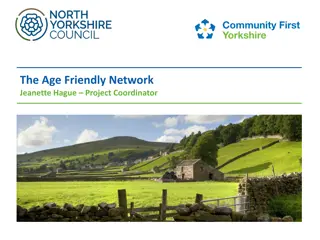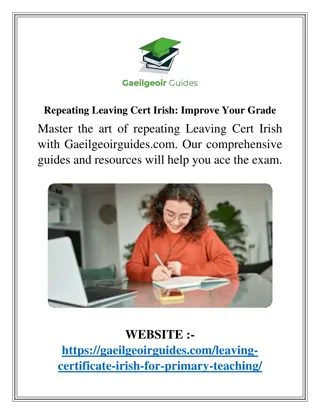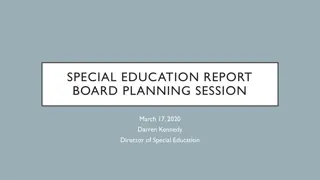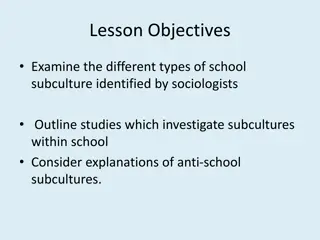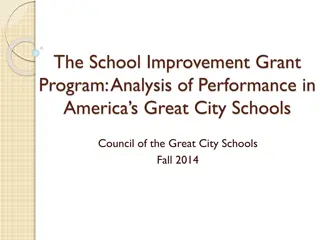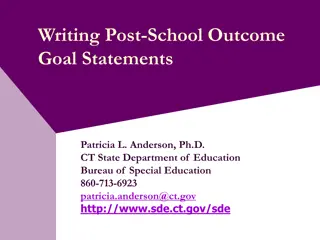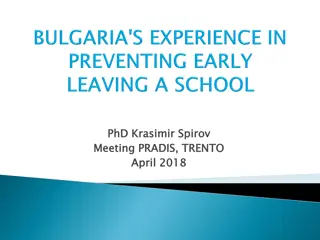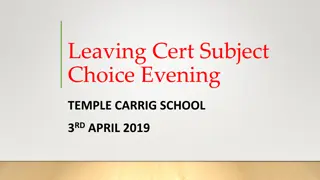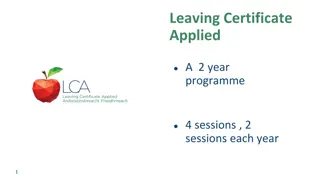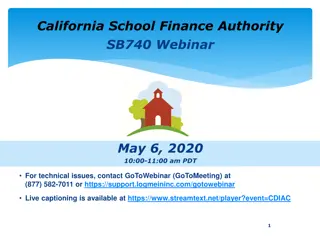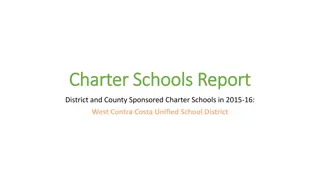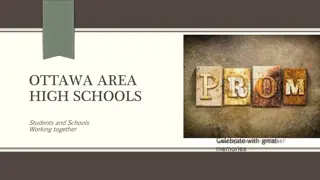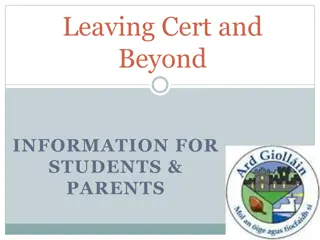Types of Schools and School Leaving Age Guidelines
Students attend various types of schools, including community schools, academies, grammar schools, foundation schools, and studio schools in England. Compulsory participation age for education or training was raised to 18 by the Education and Skills Act in 2008. Students can leave school at 16 but must continue education, start an apprenticeship, or work/volunteer part-time until 18 to avoid being classified as NEET (Not in Education, Employment, or Training).
Uploaded on Oct 07, 2024 | 0 Views
Download Presentation

Please find below an Image/Link to download the presentation.
The content on the website is provided AS IS for your information and personal use only. It may not be sold, licensed, or shared on other websites without obtaining consent from the author. Download presentation by click this link. If you encounter any issues during the download, it is possible that the publisher has removed the file from their server.
E N D
Presentation Transcript
What types of school might our students attend? And, where might you end up teaching in?
Quick starter. How long do students have to stay in school? i.e. what is the compulsory participation age for young people? The 1944 Education Act guaranteed free education for every child in England and Wales. But when could you leave school then leave school now? when could you leave school then? And when can you
Quick starter. How long do students have to stay in school? I.e. what is the compulsory participation age for young people? The government raised the school leaving age from 14 to to 15 in 1947 - but it was not until 1972 that the leaving age rose to 16. The Education and Skills Act 2008 legislated to raise the age of compulsory participation in education or training young people turn 17 in 2013 and to their 18th birthday in 2015 compulsory participation in education or training to the end of the academic year in which to their 18th birthday in 2015. Which means being in Education, Employment of Training leading to the term NEET which means? Not in education, employment or training.
You can leave school on the last Friday in June if youll be 16 by the end of the summer holidays. You mustthen do one of the following until you re 18: stay in full-time education, for example at a college start an apprenticeship or traineeship spend 20 hours or more a week working or volunteering, while in part-time education or training
Most state schools have to follow the national curriculum. The most common ones are: community schools, controlled by the local council and not influenced by business or religious groups foundation schools and voluntary schools, which have more freedom to change the way they do things than community schools academies, run by a governing body, independent from the local council - they can follow a different curriculum grammar schools, run by the council, a foundation body or a trust - they select all or most of their pupils based on academic ability and there is often an exam to get in studio schools are a type of secondary school in England that is designed to give students practical skills in workplace environments as well as traditional academic and vocational courses of study. Like traditional schools, studio schools teach the National Curriculum and offer academic and vocational qualifications. they can follow a different curriculum
Special schools with pupils aged 11 and older can specialise in 1 of the 4 areas of special educational needs: communication and interaction cognition and learning social, emotional and mental health sensory and physical needs Schools can further specialise within these categories to reflect the special needs they help with, for example Autistic spectrum disorders, visual impairment, or speech, language and communication needs (SLCN).
Faith schools have to follow the national curriculum, but they can choose what they teach in religious studies. Faith schools may have different admissions criteria and staffing policies to state schools, although anyone can apply for a place. Faith academies Faith academies don t have to teach the national curriculum and have their own admissions processes.
Free schools are funded by the government but arent run by the local council. They have more control over how they do things. They re all-ability schools, so can t use academic selection processes like a grammar school. Free schools can: set their own pay and conditions for staff change the length of school terms and the school day They don t have to follow the national curriculum.
Free schools are run on a not-for-profit basis and can be set up by groups like: charities universities independent schools community and faith groups teachers parents businesses
Academies are publicly funded independent schools. Academies don t have to follow the national curriculum and can set their own term times. They still have to follow the same rules on admissions, special educational needs and exclusions as other state schools. Academies get money directly from the government, not the local council. They re run by an academy trust which employs the staff. Some academies have sponsors such as businesses, universities, other schools, faith groups or voluntary groups. Sponsors are responsible for improving the performance of their schools.
Free schools must be in response to local demand. For most schools that means there must be a petition from parents in the area naming the school as their first choice. Free schools are completely new state schools. This means groups can think from first principles about the kind of school they would like to establish.
City technology colleges and the city college for the technology of the arts are independent schools in urban areas that are free to go to. They re funded by central government - companies can also contribute. City technology colleges emphasise teaching science and technology. The city college for the technology of the arts teaches technology in its application of performing and creative arts, for example by offering interactive digital design courses.
State boarding schools provide free education but charge fees for boarding. Most state boarding schools are academies, some are free schools and some are run by local councils. State boarding schools give priority to children who have a particular need to board and will assess children s suitability for boarding. Charities such as Buttle UK or the Royal National Children s Foundation can sometimes help with the cost of boarding. Contact the State Boarding Forum for more information about state boarding schools, eligibility and how to apply.
Private schools (also known as independent schools ) charge fees to attend instead of being funded by the government. Pupils don t have to follow the national curriculum. All private schools must be registered with the government and are inspected regularly.
Academies are independent, state-funded schools, which receive their funding directly from central government, rather than through a local authority. The day-to-day running of the school is with the head teacher or principal, but they are overseen by individual charitable bodies called academy trusts and may be part of an academy chain. These trusts and chains provide advice, support, expertise and a strategic overview. They control their own admissions process and have more freedom than other schools to innovate.
They were once. The policy, which originated under Labour, aimed to improve struggling schools, primarily in deprived areas. And this continues under the sponsored-academy model, where failing schools are taken over and run by an academy trust. But it has changed radically to embrace all types of schools - successful or otherwise. All schools - primary as well as secondary - have been invited to convert to academy status, with priority being given to the best performers.
The government argues academies drive up standards by putting more power in the hands of head teachers over pay, length of the school day and term times. They have more freedom to innovate and can opt out of the national curriculum. It says they have been shown to improve twice as fast as other state schools. Others dispute that. In the past, they have received 25,000 conversion costs from the Department for Education, and have topped up their budgets by as much as 10%, receiving funds for support services that used to go to the local council.
A series of MPs' committees have criticised the academies programme for a lack of oversight, in terms of finances and public accountability. Teaching unions have long argued that academisation has been used as a way of privatising the school system, while the government says it is about introducing innovation. Now private providers run large "chains" of schools, and some of these grew very fast - taking on more schools than they could cope with. This led to some of the largest chains being stopped from taking on any more schools. Recently, the Ofsted chief Sir Michael Wilshaw criticised seven sizeable academy chains for failing to improve the results of too many pupils in their schools, while paying board members large salaries. But he also acknowledged that great progress has been seen in many academies. that great progress has been seen in many academies.
A multi-academy trust (MAT) working in collaboration as one entity maintain high educational standards across the trust. The multi-academy trust is governed through a a single set of members and directors. (MAT) is a group of schools working in collaboration as one entity to improve and single set of members and directors. There are typically two forms of multi-academy trust: the group of schools may be an existing academy chain which a school elects to join a number of schools come together to set up a new multi-academy trust with remit, governance etc decided collectively. decided collectively.
A federation is where a number of maintained schools come together under one governing body. The schools individual governing bodies are disbanded and a new single over-arching governing body is formed. This becomes the accountable body for all the schools and sets the strategic direction for the group. Federation can be a very effective group structure, providing maintained schools opportunity to form a group - without incurring legal costs (MATS) education of pupils. maintained schools with the without incurring legal costs (MATS)- in order to improve the
Before 1992, inspections were carried out by inspectors based in Local Education Authorities who reported to the Secretary of State for Education Ofsted was established to overcome regional variations in judgements Inspection reports were published for anyone to read under the accountability agenda Later extended to cover day care and child- minding
School Governing Bodies (GBs) are made up of Head teachers, representatives of teaching and support staff, parents and co-opted members of the community GB members are volunteers, i.e. unpaid GBs typically meet twice a term and many also have a committee system with committees (e.g. Finance, Personnel, Buildings) meeting once or twice a term
They are responsible for making strategic decisions about the school, including: o setting policies and targets o setting and monitoring the budget o deciding staffing, including recruitment and, if necessary, redundancy, o managing the maintenance of the site and buildings



